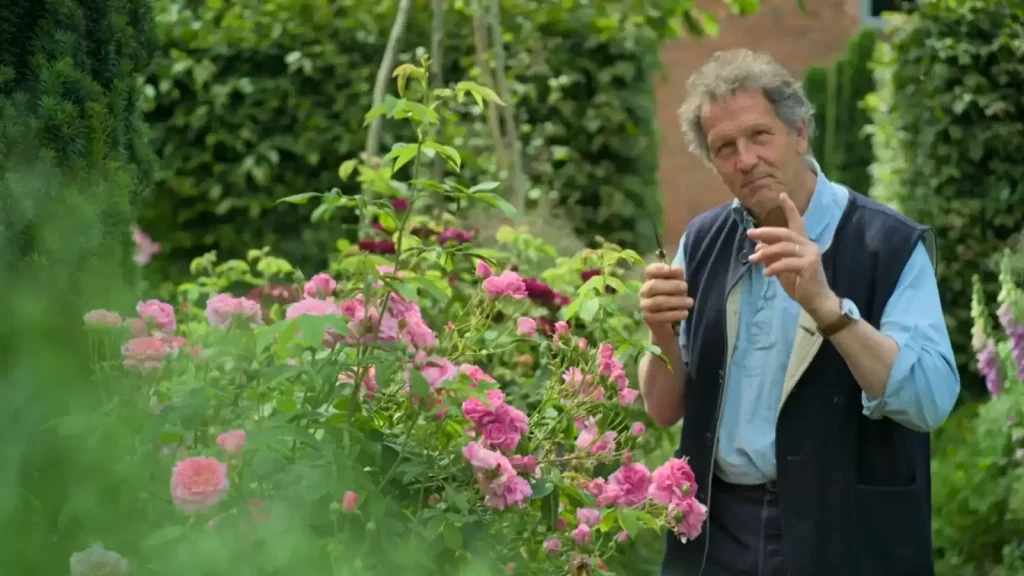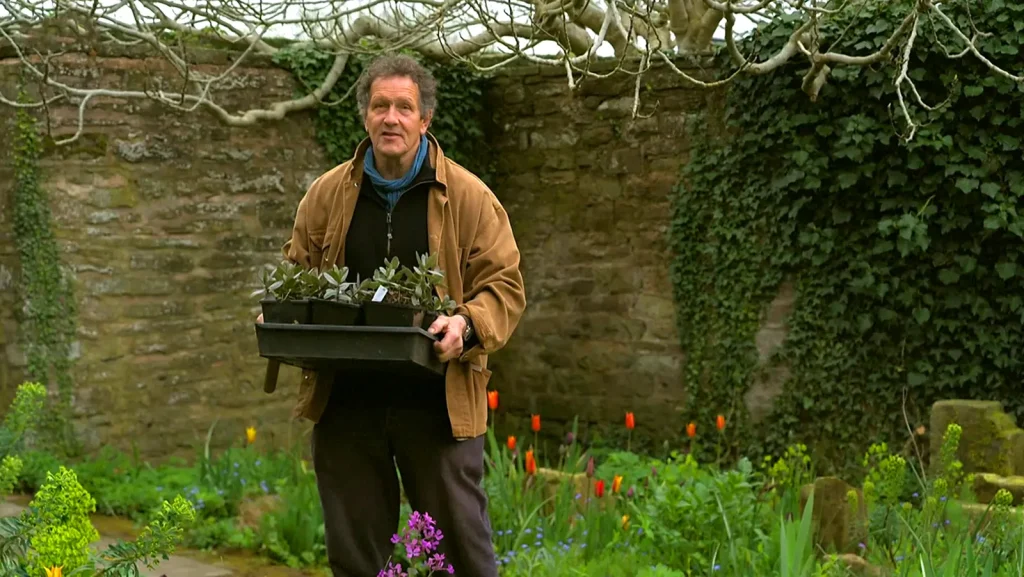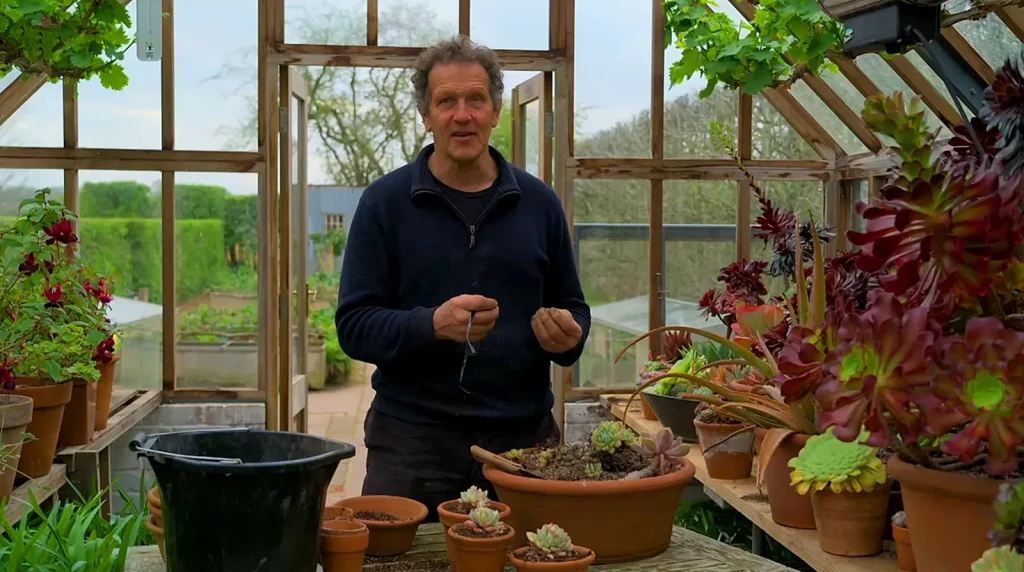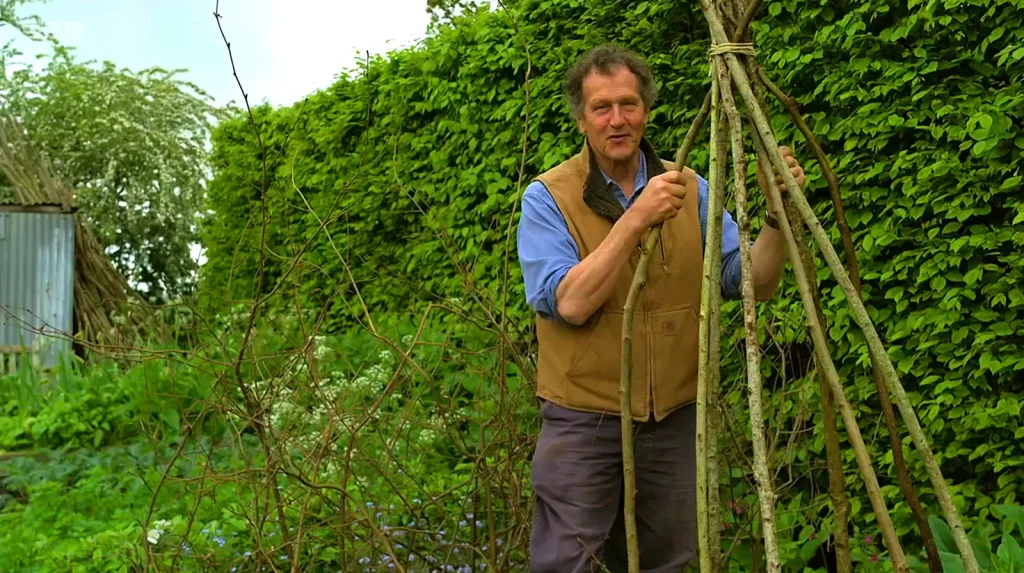Gardeners World 2024 Episode 15: At the picturesque Longmeadow, the roses are not just blooming; they are a vivid spectacle of nature’s finest work. This week, Monty Don is compelled to undertake some urgent pruning on one of his cherished crab apple trees, which promises to be a delicate task. Meanwhile, in the lush vegetable garden, the time is ripe for harvesting garlic along with an early batch of beans, marking a bountiful start to the season. Monty is also taking on a new challenge: he’s enhancing a recently constructed seating area by planting a selection of species ideally suited to the poor, shallow soil of the narrow borders surrounding it.
In another exciting development, Adam Frost embarks on a journey to the Birmingham Botanical Gardens. Here, he explores the extensive restoration project underway, aiming to bring new life to this historic site. His visit highlights the intricate processes and the dedication involved in preserving such a cherished landmark.
Simultaneously, Nick Bailey is busy laying the groundwork for what he calls his ‘forever garden.’ This episode gives us a glimpse into Nick’s creative process as he carefully selects elements that will define this personal and enduring space. His thoughtful approach to garden design combines aesthetics with functionality, ensuring that every plant and path tells a story.
Elsewhere, we meet a devoted couple whose life’s work involves the cultivation and hybridization of an impressive array of thousands of cacti. Their passion and expertise have culminated in a unique collection that not only showcases their botanical prowess but also contributes significantly to the diversity of species.
Our journey continues as we visit an extraordinary garden in Sheffield, which stands out for its creative use of space. This garden is a testament to the power of recycling and upcycling, with every corner filled with treasures that have been repurposed or collected over the years. The owners have transformed everyday objects into garden features, creating an eclectic and inspiring environment that blurs the lines between art and horticulture.
This episode, number 15 of Gardeners’ World 2024, invites viewers to delve into the world of gardening through these diverse and compelling stories. Each segment is carefully crafted to not only entertain but also educate and inspire everyone from the novice gardener to the seasoned green thumb. Join us as we explore the beauty, complexity, and joy of gardening.
Gardeners World 2024 Episode 15
Crabapple Pruning Info: When And How To Prune Crab apples
Crab apple trees are a delightful addition to any garden, offering beautiful blooms and often, tasty fruit. Proper pruning is essential not just for aesthetic reasons but also for the health and longevity of the tree. Here’s a comprehensive guide on when and how to prune your crabapple tree to keep it thriving.
When to Prune a Crab apple Tree
The optimal time to prune a crab apple tree is during its dormant season, typically in late winter to early spring. This timing ensures minimal stress on the tree and reduces the risk of disease transmission. Avoid pruning during freezing temperatures to prevent cold damage.
Consider Local Climate Variations
Depending on where you live, adjust your pruning schedule accordingly. Warmer climates may allow for earlier pruning, while colder regions should wait until the coldest part of winter has passed.
How to Prune Crab apples
Proper technique is crucial when pruning crabapple trees to maintain their health and appearance. Follow these steps for effective pruning:
Step 1: Remove Suckers and Water Sprouts
Suckers, which grow from the tree’s rootstock, and water sprouts, small shoots between branches, should be promptly removed. These not only detract from the tree’s appearance but can also harbor diseases.
Step 2: Trim Dead Branches
Dead or diseased branches should be cut back to the base or nearest healthy point. This prevents the spread of pathogens and encourages new growth.
Step 3: Shape the Tree
Prune to enhance the tree’s natural shape and structure. Remove crossing branches to allow for better airflow and light penetration, which are essential for overall tree health.
Step 4: Thinning Out
Thin out crowded branches to reduce competition and improve the tree’s vigor. This also minimizes the risk of fungal infections that thrive in dense foliage.
Meta Description: Discover expert techniques for cultivating garlic, from choosing the right varieties to harvesting and storing. This detailed guide provides essential insights and tips for growing garlic successfully, ensuring a robust crop and optimal storage conditions.
Comprehensive Guide to Growing Garlic – Getting Started with Garlic Cultivation
Choosing the Right Garlic Varieties
Garlic, a staple in culinary traditions worldwide and valued for its numerous health benefits, thrives in a warm, sunny spot with well-drained soil. It’s crucial to start with the right variety. Planting supermarket garlic is discouraged due to potential disease and unsuitability for specific climates. Instead, source named varieties from garden centers or specialized online retailers. Opt for those with an RHS Award of Garden Merit (AGM) to ensure robust growth and yield.
Hardneck vs. Softneck Garlic
- Hardneck Garlic: Known for fewer but larger cloves and a robust flavor, hardneck varieties are ideal for colder climates as they require a chilling period to develop bulbs. They are more likely to bolt (flower prematurely) and have a shorter storage life.
- Softneck Garlic: These varieties produce more cloves that are smaller and packed tighter together, making them easier to braid and store for longer periods. Softneck garlic is less prone to bolting and is suitable for milder climates.
Preparing the Ground
Garlic favors a sunny location with soil that drains well. Heavy, wet soils can lead to disease; therefore, improving the soil with ample organic matter like well-rotted manure or garden compost is recommended. For soil that is too acidic, applying lime to adjust the pH level can be beneficial.
Planting Garlic
Timing and Technique
Plant garlic cloves in late autumn for a summer harvest. This timing allows garlic to experience necessary cold periods for bulb development. Plant cloves pointy-end up, spaced about 15cm apart, and just deep enough to cover with soil. In areas with heavy soil, consider starting garlic in modules in a cold frame and transplanting in the spring.
Garlic Plant Care
Watering and Weeding
Garlic requires minimal maintenance. Keep the soil weed-free and water during dry spells to encourage growth. Avoid watering once the bulbs are mature, as excess moisture can cause rot. Mulching can help retain soil moisture and suppress weeds.
Harvesting Garlic
Garlic is ready to harvest when the leaves turn yellow, typically in early summer. Gently lift the bulbs with a fork, taking care not to bruise them as this can affect their storage potential. Freshly harvested garlic can be used immediately or cured for storage.
Storing Garlic
Dry harvested garlic in a single layer under a cloche or in a well-ventilated area. Once dry, trim off the foliage and store in a cool, dry place. Properly cured garlic can be stored for several months, especially softneck varieties which have a longer shelf life.
F.A.Q. Gardeners World 2024 Episode 15
Q.: What can viewers expect from Monty Don’s segment in Gardeners’ World 2024 Episode 15?
A.: Viewers will see Monty Don engaging in the delicate task of pruning a cherished crab apple tree at Longmeadow, which is essential for maintaining the tree’s health and aesthetic appeal. Additionally, Monty tackles a project to enhance a recently constructed seating area by planting species suited for shallow, poor soil, making this episode a rich source of practical gardening tips.
Q.: How does Adam Frost contribute to Gardeners’ World 2024 Episode 15?
A.: In this episode, Adam Frost visits the Birmingham Botanical Gardens to explore a significant restoration project aimed at revitalizing this historic site. His segment provides insight into the restoration processes and the dedication required to preserve such a treasured landmark, offering inspiration and education to garden enthusiasts interested in botanical conservation.
Q.: What is unique about Nick Bailey’s ‘forever garden’ featured in the episode?
A.: Nick Bailey’s segment in the episode delves into his creative process in designing his ‘forever garden,’ where he meticulously selects elements that ensure both aesthetics and functionality. His approach is geared towards creating a sustainable and personal garden space where every plant and path narratively contributes to the garden’s story, appealing to viewers who appreciate thoughtful landscape design.
Q.: Can you tell us more about the special collection featured in this episode?
A.: The episode introduces a devoted couple deeply involved in the cultivation and hybridization of an extensive array of cacti. Their segment highlights their expertise and the diverse species they’ve developed, providing a captivating look into specialized botanical cultivation and how it contributes to the broader biodiversity.
A.: The crabapple pruning guide included in the episode outlines crucial techniques for maintaining the health and beauty of crabapple trees. Key steps include removing suckers and water sprouts, trimming dead or diseased branches, shaping the tree to enhance its natural form, and thinning out crowded branches to prevent fungal infections and boost overall vigor.




